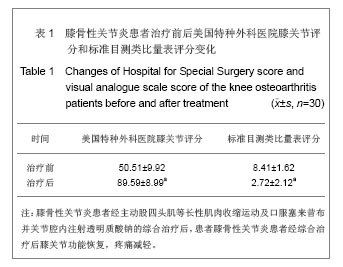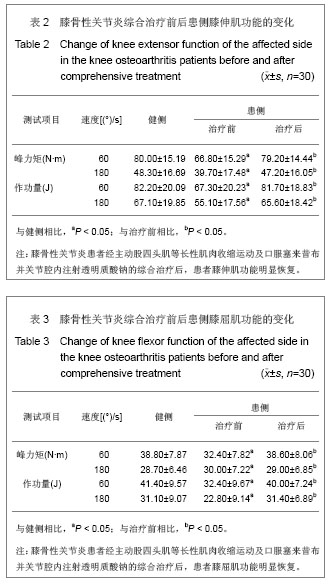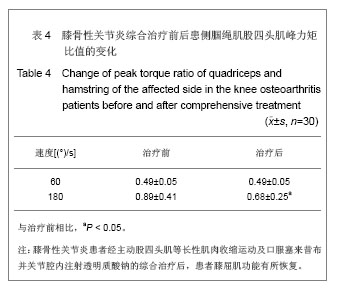| [1]Rousseau JC, Delmas PD. Biological markers in osteoarthritis. Nat Clin Pract Rheumatol. 2007;3(6):346-356.
[2]Cheung PP, Gossec L, Dougados M. What are the best markers for disease progression in osteoarthritis (OA)? Best Pract Res Clin Rheumatol. 2010;24(1):81-92.
[3]Slemenda C, Brandt KD, Heilman DK, et al. Quadriceps weakness and osteoarthritis of the knee. Ann Intern Med. 1997; 127(2):97-104.
[4]Bennell KL, Wrigley TV, Hunt MA, et al. Update on the role of muscle in the genesis and management of knee osteoarthritis. Rheum Dis Clin North Am. 2013;39(1):145-176.
[5]Bennell KL, Hunt MA, Wrigley TV, et al. Muscle and exercise in the prevention and management of knee osteoarthritis: an internal medicine specialist's guide. Med Clin North Am. 2009; 93(1):161-177, xii.
[6]Kon E, Filardo G, Drobnic M, et al. Non-surgical management of early knee osteoarthritis. Knee Surg Sports Traumatol Arthrosc. 2012;20(3):436-449.
[7]Diehl P, Gerdesmeyer L, Schauwecker J, et al. [Conservative therapy of osteoarthritis]. Orthopade. 2013;42(2):125-139.
[8]Insall JN, Ranawat CS, Aglietti P, et al. A comparison of four models of total knee-replacement prostheses. J Bone Joint Surg Am. 1976;58(6):754-765.
[9]Hofmann AA, Bloebaum RD, Koller KE, et al. Does celecoxib have an adverse effect on bone remodeling and ingrowth in humans? Clin Orthop Relat Res. 2006;452:200-204.
[10]Schroer WC, Diesfeld PJ, LeMarr AR, et al. Benefits of prolonged postoperative cyclooxygenase-2 inhibitor administration on total knee arthroplasty recovery: a double-blind, placebo-controlled study. J Arthroplasty. 2011; 26(6 Suppl):2-7.
[11]Hegazy R, Alashhab M, Amin M. Cardiorenal effects of newer NSAIDs (Celecoxib) versus classic NSAIDs (Ibuprofen) in patients with arthritis. J Toxicol. 2011;2011:862153.
[12]Lee W, Suh JW, Yang HM, et al. Celecoxib does not attenuate the antiplatelet effects of aspirin and clopidogrel in healthy volunteers. Korean Circ J. 2010;40(7):321-327.
[13]Strand V, Simon LS, Dougados M, et al. Treatment of osteoarthritis with continuous versus intermittent celecoxib. J Rheumatol. 2011;38(12):2625-2634.
[14]Chan FK, Lanas A, Scheiman J, et al. Celecoxib versus omeprazole and diclofenac in patients with osteoarthritis and rheumatoid arthritis (CONDOR): a randomised trial. Lancet. 2010;376(9736):173-179.
[15]Lanas A, Tornero J, Zamorano JL. Assessment of gastrointestinal and cardiovascular risk in patients with osteoarthritis who require NSAIDs: the LOGICA study. Ann Rheum Dis. 2010;69(8):1453-1458.
[16]Cryer B, Li C, Simon LS, et al. GI-REASONS: a novel 6-month, prospective, randomized, open-label, blinded endpoint (PROBE) trial. Am J Gastroenterol. 2013;108(3):392-400.
[17]Peri? A, Toski?-Radoji?i? M, Dobri? S, et al. Are COX-2 inhibitors preferable to combined NSAID and PPI in countries with moderate health service expenditures? J Eval Clin Pract. 2010;16(6):1090-1095.
[18]Kon E, Mandelbaum B, Buda R, et al. Platelet-rich plasma intra- articular injection versus hyaluronic acid viscosupplementation as treatments for cartilage pathology: from early degeneration to osteoarthritis. Arthroscopy. 2011;27(11):1490-1501.
[19]Filardo G, Kon E, Pereira Ruiz MT, et al. Platelet-rich plasma intra-articular injections for cartilage degeneration and osteoarthritis: single- versus double-spinning approach. Knee Surg Sports Traumatol Arthrosc. 2012;20(10):2082-2091.
[20]Jüni P, Rutjes AW, da Costa BR, et al. Viscosupplementation for osteoarthritis of the knee. Ann Intern Med. 2013;158(1):75.
[21]Swi?chowicz S, Osta?owska A, Kasperczyk A, et al. Evaluation of hyaluronic acid intra-articular injections in the treatment of primary and secondary osteoarthritis of the knee. Pol Orthop Traumatol. 2012;77:105-109.
[22]McArthur BA, Dy CJ, Fabricant PD, et al. Long term safety, efficacy, and patient acceptability of hyaluronic acid injection in patients with painful osteoarthritis of the knee. Patient Prefer Adherence. 2012;6:905-910.
[23]Navarro-Sarabia F, Coronel P, Collantes E, et al. A 40-month multicentre, randomised placebo-controlled study to assess the efficacy and carry-over effect of repeated intra-articular injections of hyaluronic acid in knee osteoarthritis: the AMELIA project. Ann Rheum Dis. 2011;70(11):1957-1962.
[24]Chevalier X. Forty-month trial suggests repeated hyaluronic acid injections for people with knee osteoarthritis may act as a long- term slow acting drug. Evid Based Med. 2012;17(6):188-189.
[25]Atkins DV, Eichler DA. The effects of self-massage on osteoarthritis of the knee: a randomized, controlled trial. Int J Ther Massage Bodywork. 2013;6(1):4-14.
[26]蒋奇永,徐秀林.等长肌力测试的研究与应用[J].中国组织工程研究与临床康复,2011,15(15):2813-2816.
[27]Rosa UH, Velásquez Tlapanco J, Lara Maya C, et al. Comparison of the effectiveness of isokinetic vs isometric therapeutic exercise in patients with osteoarthritis of knee. Reumatol Clin. 2012;8(1):10-14. |



.jpg)